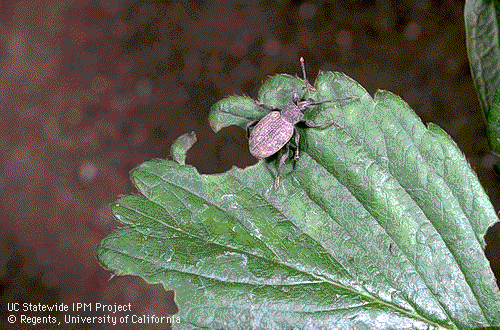Strawberry root weevil complex
Cribrate weevil: Otiorhynchus cribricollis
Woods weevil: Nemocestes incomptus
Black vine weevil: Otiorhynchus sulcatus
Fuller rose weevil: Pantomorus cervinus
(Coleoptera: Curculionidae)

Description:
Adult root weevils are snout beetles of various species. They are light
brown to black in color, and all possess hard-shelled bodies with rows
of pits on the elytra. They feed at night and hide within the crowns of
plants during the day. Root weevil adults do not fly. Root weevil
larvae
have curved, white or pink bodies that are about 0.38 inch long (nearly
10 mm)when fully grown. They have distinct brown heads, but no legs.

Biology and damage:
Larvae feed on the roots of strawberry plants and can completely devour
small rootlets and destroy the bark and cortex of larger roots. Injured
plants often wilt because the roots can no longer provide moisture for
leaves. Weevil larvae can also be found burrowed into the lower portion
of the plant's crown. Adults feed on foliage and remove large scallops
from the leaves. Such leaf damage is a good indication that weevils are
present, but is not economically damaging to the plants.
Root weevils have a single generation each year (Davidson & Lyon
1987).
The flightless adult females reproduce parthenogenetically. Adults
emerge
in late spring or summer, feed on strawberry foliage, and females lay
their
eggs around the crowns about 1 month after emergence. After hatching,
weevil
larvae burrow into the soil and feed on strawberry roots and crowns.
The
insects overwinter as mature larvae in the soil. In spring, they resume
feeding and can cause extensive damage before they pupate.
Management:
CHEMICAL CONTROL
Chemical treatment is not needed each and every year since these
flightless
beetles are slow to colonize a field. Controls are now directed against
adults while they are feeding on crop foliage (see postharvest
spray). Formerly, surface soil treatment with Furadan 4 F
where
root weevil has been a problem was effective for controlling this pest,
applied in Virginia between harvest and October 1. However the 24(c)
registration
for this use was voluntarily withdrawn by the manufacturer in the
winter
of 1996-1997. The USEPA authorized FMC Corporation to sell and
distribute
carbofuran for use on strawberries until 5/14/98. Growers and
distributors
may use existing stocks until they are depleted.
Virginia
commercial
small
fruit guidelines
Virginia
home
spray
guidelines
California
guidelines
BIOLOGICAL CONTROL:
Very few natural enemies.
CULTURAL CONTROL:
Crop rotation. Avoid planting strawberries after sod. Delay plowing
until fall in order to use old planting as a trap crop for weevil
oviposition.
Sticky barriers can be used to prevent movement of adult weevils from
infested
second year berries and host areas to newly fumigated plantings.

